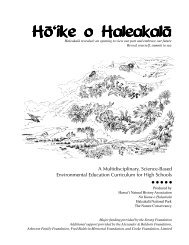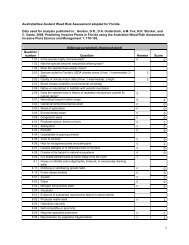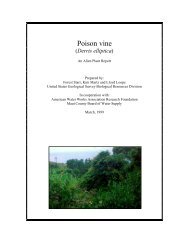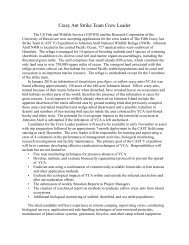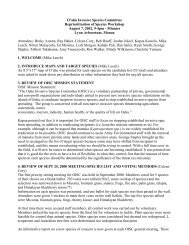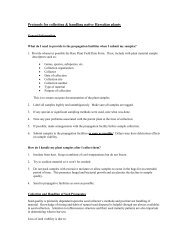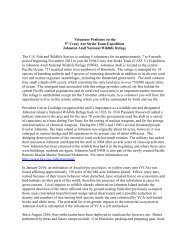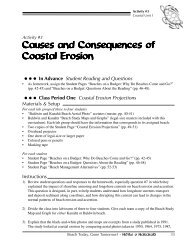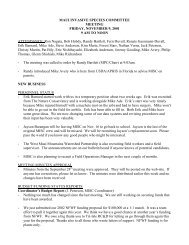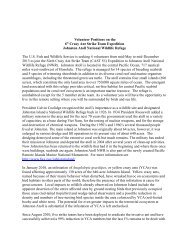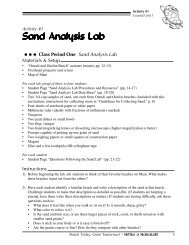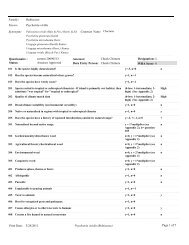Report to the Republic of Palau: 2008 update on Invasive Plant ...
Report to the Republic of Palau: 2008 update on Invasive Plant ...
Report to the Republic of Palau: 2008 update on Invasive Plant ...
You also want an ePaper? Increase the reach of your titles
YUMPU automatically turns print PDFs into web optimized ePapers that Google loves.
It was searched for but not seen in <str<strong>on</strong>g>2008</str<strong>on</strong>g>. This species has become established as a pest species<br />
<strong>on</strong> a number <str<strong>on</strong>g>of</str<strong>on</strong>g> Pacific islands. It can form dense thickets, particularly in disturbed areas. As it<br />
has been recorded as present in Babeldaob for a l<strong>on</strong>g time (Fosberg et al., 1979) it may not<br />
become a serious pest here although its risk assessment indicates that it is high risk with a score<br />
<str<strong>on</strong>g>of</str<strong>on</strong>g> 8.<br />
Vitex parviflora (small-leaved vitex) was reported present in <str<strong>on</strong>g>Palau</str<strong>on</strong>g> by Fosberg et al. (1979), but<br />
has not been seen recently. It may be present in cultivati<strong>on</strong>. It is a native <str<strong>on</strong>g>of</str<strong>on</strong>g> <str<strong>on</strong>g>the</str<strong>on</strong>g> Philippines, has<br />
bird-dispersed seeds and is invasive in Guam.<br />
4. O<str<strong>on</strong>g>the</str<strong>on</strong>g>r species <str<strong>on</strong>g>of</str<strong>on</strong>g> c<strong>on</strong>cern that are known <str<strong>on</strong>g>to</str<strong>on</strong>g> be weedy or invasive elsewhere<br />
and are comm<strong>on</strong>, weedy or cultivated in <str<strong>on</strong>g>Palau</str<strong>on</strong>g><br />
A large number <str<strong>on</strong>g>of</str<strong>on</strong>g> o<str<strong>on</strong>g>the</str<strong>on</strong>g>r comm<strong>on</strong> or weedy introduced species were noted. Many <str<strong>on</strong>g>of</str<strong>on</strong>g> <str<strong>on</strong>g>the</str<strong>on</strong>g>se<br />
species might best be termed aggressive weeds, and are mostly prevalent al<strong>on</strong>g roadsides or <strong>on</strong><br />
disturbed sites. In <str<strong>on</strong>g>the</str<strong>on</strong>g> case <str<strong>on</strong>g>of</str<strong>on</strong>g> vines and plants that form dense ground cover, <str<strong>on</strong>g>the</str<strong>on</strong>g> regenerati<strong>on</strong> <str<strong>on</strong>g>of</str<strong>on</strong>g><br />
native species might be inhibited if <str<strong>on</strong>g>the</str<strong>on</strong>g>y became widespread. Quite a number <str<strong>on</strong>g>of</str<strong>on</strong>g> alien trees have<br />
also been introduced, some <str<strong>on</strong>g>of</str<strong>on</strong>g> which may have <str<strong>on</strong>g>the</str<strong>on</strong>g> potential <str<strong>on</strong>g>to</str<strong>on</strong>g> spread in<str<strong>on</strong>g>to</str<strong>on</strong>g> forested ecosystems.<br />
Some species that are not widespread could become a problem in <str<strong>on</strong>g>the</str<strong>on</strong>g> future, since <str<strong>on</strong>g>the</str<strong>on</strong>g>re is <str<strong>on</strong>g>of</str<strong>on</strong>g>ten a<br />
l<strong>on</strong>g lag time between introducti<strong>on</strong> and when a species begins <str<strong>on</strong>g>to</str<strong>on</strong>g> cause serious impacts. The<br />
species thought <str<strong>on</strong>g>to</str<strong>on</strong>g> be <str<strong>on</strong>g>of</str<strong>on</strong>g> envir<strong>on</strong>mental c<strong>on</strong>cern are listed in Appendix 1 Table 3. When not<br />
already widespread, <str<strong>on</strong>g>the</str<strong>on</strong>g>se species should be m<strong>on</strong>i<str<strong>on</strong>g>to</str<strong>on</strong>g>red and c<strong>on</strong>trol measures instigated, if<br />
necessary. The more problematic <strong>on</strong>es are listed and discussed below. A number <str<strong>on</strong>g>of</str<strong>on</strong>g> o<str<strong>on</strong>g>the</str<strong>on</strong>g>r<br />
species, thought <str<strong>on</strong>g>to</str<strong>on</strong>g> be <str<strong>on</strong>g>of</str<strong>on</strong>g> low risk or agricultural c<strong>on</strong>cern, are listed in Appendix 1, Table 4.<br />
Acacia auriculiformis (earleaf acacia, earpod wattle) is widely planted but in <strong>on</strong>ly a few cases<br />
were significant numbers <str<strong>on</strong>g>of</str<strong>on</strong>g> seedlings present, usually where mineral soil was exposed as a result<br />
<str<strong>on</strong>g>of</str<strong>on</strong>g> fire or o<str<strong>on</strong>g>the</str<strong>on</strong>g>r disturbance. However, it has a weed risk assessment score <str<strong>on</strong>g>of</str<strong>on</strong>g> 13, “high risk”.<br />
Naturalizati<strong>on</strong> may increase with more disturbance or fire activity.<br />
Spiny Barleria lupulina (hophead, Philippine violet) was seen in cultivati<strong>on</strong> in Ngchesar State in<br />
2002 and in Peleliu in <str<strong>on</strong>g>2008</str<strong>on</strong>g>. The owner <str<strong>on</strong>g>of</str<strong>on</strong>g> <str<strong>on</strong>g>the</str<strong>on</strong>g> plant in Ngchesar destroyed it when asked <str<strong>on</strong>g>to</str<strong>on</strong>g> do<br />
so. The owner <str<strong>on</strong>g>of</str<strong>on</strong>g> <str<strong>on</strong>g>the</str<strong>on</strong>g> plant in Peleliu should be requested <str<strong>on</strong>g>to</str<strong>on</strong>g> do <str<strong>on</strong>g>the</str<strong>on</strong>g> same. It is invasive in Timor<br />
and some naturalizati<strong>on</strong> has been noted in north Queensland (Barbara Waterhouse, pers. com.)<br />
and Hawai‘i (Wagner et al., 1999).<br />
Bryophyllum pinnatum [=Kalanchoë pinnata] (life plant) is present in cultivati<strong>on</strong> and some<br />
seedlings were noted in <str<strong>on</strong>g>the</str<strong>on</strong>g> 2002 survey. Bryophyllum delagoense [=Kalanchoë tubiflora]<br />
(chandelier plant) was seen <strong>on</strong> Babeldaob in <str<strong>on</strong>g>2008</str<strong>on</strong>g> and likely is present elsewhere. Both <str<strong>on</strong>g>the</str<strong>on</strong>g>se<br />
species reproduce vegetatively and can be invasive <strong>on</strong> <str<strong>on</strong>g>the</str<strong>on</strong>g> forest floor, particular <strong>on</strong> dry, rocky<br />
sites.<br />
Calotropis gigantea (calotrope, crown flower, madar) is found in cultivati<strong>on</strong> <strong>on</strong> Koror,<br />
Ngerkebesang, Babeldaob and Peleliu. It is an invasive species in Timor and has naturalized in<br />
northwestern Australia and some Hawaiian Islands.<br />
Duranta erecta (golden dewdrop) is widely planted as an ornamental. It produces prodigious<br />
amounts <str<strong>on</strong>g>of</str<strong>on</strong>g> fruit and is reported <str<strong>on</strong>g>to</str<strong>on</strong>g> be naturalizing in Hawai‘i, Florida and Queensland,<br />
18



